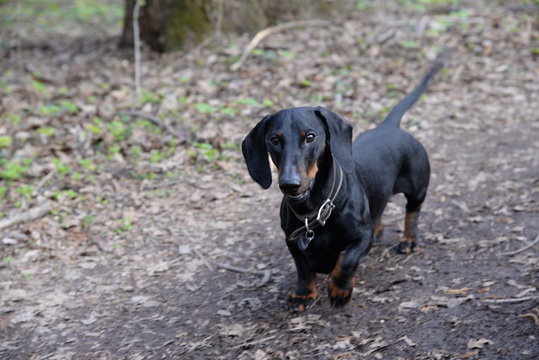
The Dachsador is a mixed breed dog-a cross between the Dachshund and Labrador Retriever dog breeds. Lively, active, and friendly, these pups inherited some of the best qualities from both of their parents.
Dachsadors are also sometimes known as Doxadors, Doxidors, and Weinerdors. You can find these mixed breed dogs in shelters and breed specific rescues, so remember to always adopt! Don't shop if you're looking to add a Dachsador to your home!
Dachsadors are friendly and super social dogs who will be a big hit with families. The breed will seek out human companionship and is always in the mood for cuddle sessions on the couch. A relatively low maintenance dog when it comes to grooming, the Dachsador does have a playful streak that means this high energy mixed breed will require regular exercise. If you're an active family, this dog will fit in with your routine perfectly.
More About This Breed
Highlights
The Dachsador is a mixed breed dog. They are not purebreds like their Dachshund or Labrador Retriever parents.
The most common Dachsador colors are chocolate brown, black, and yellow.
The Dachsador is a high energy dog that will need at least two walks a day, ideally between 45 minutes and an hour.
When it comes to grooming, a quick ten minute brushing session every day or so should be enough to keep the dog's coat in tip top condition.
Dachsador dogs and children are a great fit for each other. The mixed breed is friendly and playful and will love to take part in play sessions with the kids. Play time should still always be supervised.
This dog is smart, so make sure to provide interactive toys to keep them alert and intrigued.
History
There's a bit of mystery involved with the Dachsador. It's believed the breed was invented during the last couple of decades, but their exact origin story is still unknown.
When it comes to the Dachsador's parent breeds, the Labrador Retriever originates from Canada, where they were originally bred for hunting and retrieving before settling into a role as a guide dog. These days, the Labrador Retriever is one of the most popular dogs in the United States.
The Dachshund comes from Germany, where they gained a reputation as a skilled badger hunter. The breed's name becomes "badger hound" when translated from German! Since then, the Dachshund has embraced a role as a top notch companion dog.
The Dachsador has become known as a designer dog breed, but many of them unfortunately end up in shelters. So consider contacting your local rescue groups and shelters if you're thinking about adding the Dachsador to your home.
Size
The Dachsador is usually described as a small dog. Although, as is always the case with newer mixed dog breeds, exact size standards might vary.
Most weigh in at 30 to 40 pounds and range in height from 15 to 25 inches.
Health
Dachsadors are generally considered to be healthy dogs; although, the breed can be predisposed to some of the same conditions that the Labrador Retriever and Dachshund face. As always, it's important to schedule regular wellness visits with your dog's vet.
Some of the more common health problems Dachsadors suffer from include:
Hip Dysplasia
Back problems
Eye conditions
Care
As with all dogs, it's important to keep up your Dachsador's regular veterinary checkups to detect any health concerns early. Your vet can help you develop a care routine that will keep your dog healthy.
The Dachsador is a high energy dog that will need at least two walks a day, ideally between 45 minutes and an hour. Such a smart dog will also benefit from obedience training--with suitable rewards, of course!
Outside of exercise, you'll need to brush the breed's teeth around three times a week. This is important to avoid any periodontal problems. Ask your regular vet to recommend a brand of toothpaste and offer tips on brushing technique if needed.
You'll also need to monitor and clip your Dachsador's nails every couple of weeks. Check their ears for pests and debris regularly, especially after outdoor play. Clean them as recommended by your vet.
:max_bytes(150000):strip_icc():format(webp)/what-horses-eat-that-keep-them-healthy-1886504-FINAL-5ba8dd3746e0fb0025eb2cb4.png)
:max_bytes(150000):strip_icc():format(webp)/horse-eye-resized-56a4dbf03df78cf77284fe95.jpg)
:max_bytes(150000):strip_icc():format(webp)/Horse-grooming-GettyImages-495726400-5876f27d5f9b584db351222e.jpg)
:max_bytes(150000):strip_icc():format(webp)/close-up-of-hand-holding-parrot-705172843-5b52bc4ec9e77c0037b6e5a4.jpg)
:max_bytes(150000):strip_icc():format(webp)/GettyImages-579524112-5c77331146e0fb000140a3a6.jpg)
:max_bytes(150000):strip_icc():format(webp)/budgerigarsonrope-331834_1920-5b628213c9e77c00255b32bc.jpg)
:max_bytes(150000):strip_icc():format(webp)/GettyImages-106887241-58325bc03df78c6f6a9a2ed2.jpg)
:max_bytes(150000):strip_icc():format(webp)/GettyImages-878015800-06106157c9d34a2081db4abcae8699b1.jpg)
:max_bytes(150000):strip_icc():format(webp)/hungry-cat-57b72fac5f9b58cdfda11a62.jpg)


:max_bytes(150000):strip_icc():format(webp)/4374985466_59c7f6545b_o-8b4f24f2f3e544349fe537fde58cfad0.jpg)
:max_bytes(150000):strip_icc():format(webp)/GettyImages-9298737261-500c5a2fba4248f89d1c17a33bf438f7.jpg)
:max_bytes(150000):strip_icc():format(webp)/veterinarian-and-owners-examining-dog-in-vet-s-surgery-164853745-dbecbdb691d549d79487d84356920cf4.jpg)